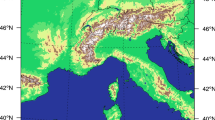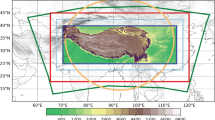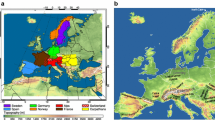Abstract
This paper presents the first multi-model ensemble of 10-year, “convection-permitting” kilometer-scale regional climate model (RCM) scenario simulations downscaled from selected CMIP5 GCM projections for historical and end of century time slices. The technique is to first downscale the CMIP5 GCM projections to an intermediate 12–15 km resolution grid using RCMs, and then use these fields to downscale further to the kilometer scale. The aim of the paper is to provide an overview of the representation of the precipitation characteristics and their projected changes over the greater Alpine domain within a Coordinated Regional Climate Downscaling Experiment Flagship Pilot Study and the European Climate Prediction system project, tasked with investigating convective processes at the kilometer scale. An ensemble of 12 simulations performed by different research groups around Europe is analyzed. The simulations are evaluated through comparison with high resolution observations while the complementary ensemble of 12 km resolution driving models is used as a benchmark to evaluate the added value of the convection-permitting ensemble. The results show that the kilometer-scale ensemble is able to improve the representation of fine scale details of mean daily, wet-day/hour frequency, wet-day/hour intensity and heavy precipitation on a seasonal scale, reducing uncertainty over some regions. It also improves the representation of the summer diurnal cycle, showing more realistic onset and peak of convection. The kilometer-scale ensemble refines and enhances the projected patterns of change from the coarser resolution simulations and even modifies the sign of the precipitation intensity change and heavy precipitation over some regions. The convection permitting simulations also show larger changes for all indices over the diurnal cycle, also suggesting a change in the duration of convection over some regions. A larger positive change of frequency of heavy to severe precipitation is found. The results are encouraging towards the use of convection-permitting model ensembles to produce robust assessments of the local impacts of future climate change.











Similar content being viewed by others
References
Baldauf M, Seifert A, Foerstner J, Majewski D, Raschendorfer M, Reinhardt T (2011) Operational convective-scale numerical weather prediction with the COSMO model: description and sensitivities. Mon Weather Rev 139:3887–3905. https://doi.org/10.1175/MWR-D-10-05013.1
Ban N, Schmidli J, Schär C (2014) Evaluation of the convection-resolving regional climate modeling approach in decade-long simulations. J Geophys Res Atmos 119:7889–7907. https://doi.org/10.1002/2014JD021478
Ban N, Schmidli J, Schär C (2015) Heavy precipitation in a changing climate: does short-term summer precipitation increase faster? Geophys Res Lett 42:1165–1172. https://doi.org/10.1002/2014GL062588
Ban N, Brisson E, Caillaud C, Coppola E, Pichelli E, Sobolowski S et al (2021) The first multi-model ensemble of regional climate simulations at the kilometer-scale resolution, Part I: Evaluation of precipitation. Clim Dyn (accepted)
Bechtold P, Chaboureau J-P, Beljaars A, Betts AK, Kohler M, Miller M, Redelsperger J-L (2004) The simulation of the diurnal cycle of convective precipitation over land in a global model. Q J R Meteorol Soc 130:3119–3137
Belušić D, de Vries H, Dobler A, Landgren O, Lind P, Lindstedt D, Pedersen RA, Sánchez-Perrino JC, Toivonen E, van Ulft B, Wang F, Andrae U, Batrak Y, Kjellström E, Lenderink G, Nikulin G, Pietikäinen J-P, Rodríguez-Camino E, Samuelsson P, van Meijgaard E, Wu M (2020) HCLIM38: a flexible regional climate model applicable for different climate zones from coarse to convection-permitting scales. Geosci Model Dev 13:1311–1333. https://doi.org/10.5194/gmd-13-1311-2020
Berthou S, Kendon E, Chan S, Ban N, Leutwyler D, Schar C, Fosser G (2018) Pan-European climate at convection-permitting scale: a model intercomparison study. Clim Dyn. https://doi.org/10.1007/s00382-018-4114-6
Brockhaus P, Lüthi D, Schär C (2008) Aspects of the diurnal cycle in a regional climate model. Meteorol Z 17:433–443
Brogli R, Kröner N, Sørland SL, Lüthi D, Schär C (2019) The role of Hadley circulation and lapse-rate changes for the futureEuropean summer climateJ. Climate 32:385–404
Caillaud C, Somot S, Alias A, Bernard-Bouissières I, Fumière Q, Laurantin O, Seity Y, Ducrocq V (2020) Modelling Mediterranean Heavy Precipitation Events at climate scale: an object-oriented evaluation of the CNRM-AROME Convection-Permitting Regional Climate Model. Clim Dyn. https://doi.org/10.1007/s00382-020-05558-y
Chan SC, Kendon EJ, Fowler HJ, Blenkinsop S, Ferro CAT, Stephenson DB (2013) Does increasing the spatial resolution of a regional climate model improve the simulated daily precipitation? Clim Dyn 41(5):1475–1495. https://doi.org/10.1007/s00382-012-1568-9
Chan SC, Kendon EJ, Roberts NM, Fowler HJ, Blenkinsop S (2016) Downturn in scaling of UK extreme rainfall with temperature for future hottest days. Nat Geosci 9:24–28
Chan SC, Kendon EJ, Berthou S et al (2020) Europe-wide precipitation projections at convection permitting scale with the Unified Model. Clim Dyn 55:409–428. https://doi.org/10.1007/s00382-020-05192-8
Coppola E, Sobolowski S, Pichelli E et al (2020a) A first-of-its-kind multi-model convection permitting ensemble for investigating convective phenomena over Europe and the Mediterranean. Clim Dyn 55:3–34. https://doi.org/10.1007/s00382-018-4521-8
Coppola E, Nogherotto R, Ciarlo JM, Giorgi F, van Meijgaardm E, Iles C et al (2020b) Assessment of the European climate projections as simulated by the large EURO-CORDEX regional climate model ensemble. J Geophys Res Atmos. https://doi.org/10.1029/2019JD032356
Cornes R, van der Schrier G, van den Besselaar EJM, Jones PD (2018) An ensemble version of the E-OBS temperature and precipitation datasets. J Geophys Res Atmos. https://doi.org/10.1029/2017JD028200
Dai A, Giorgi F, Trenberth KE (1999) Observed and model-simulated diurnal cycles of precipitation over the contiguous United States. J Geophys Res 104(D6):6377–6402
Dirmeyer PA et al (2012) Simulating the diurnal cycle of rainfall in global climate models: resolution versus parametrization. Clim Dyn 39:399–418
Ducrocq V, Braud I, Davolio S, Ferretti R, Flamant C, Jansa A, Kalthoff N, Richard E, Taupier-Letage I, Ayral PA, Belamari S, Berne A, Borga M, Boudevillain B, Bock O, Boichard JL, Bouin MN, Bousquet O, Bouvier C, Chiggiato J, Cimini D, Corsmeier U, Coppola L, Cocquerez P, Defer E, Drobinski P, Dufournet Y, Fourrie N, Gourley JJ, Labatut L, Lambert D, Le Coz J, Marzano FS, Molinie G, Montani A, Nord G, Nuret M, Ramage K, Rison B, Roussot O, Said F, Schwarzenboeck A, Testor P, Van Baelen J, Vincendon B, Aran M, Tamayo J (2014) HyMeX-SOP1, the field campaign dedicated to heavy precipitation and flash flooding in the northwestern Mediterranean. Bull Am Meteorol Soc 95:1083–1100. https://doi.org/10.1175/BAMS-D-12-00244
Fantini A (2019) Ph. D. Thesis: climate change impact on flood hazard over Italy. http://hdl.handle.net/11368/2940009
Fosser G, Khodayar S, Berg P (2015) Benefit of convection permitting climate model simulations in the representation of convective precipitation. Clim Dyn 44:45–60. https://doi.org/10.1007/s00382-014-2242-1
Fosser G, Khodayar S, Berg P (2017) 2016: climate change in the next 30 years: what can a convection-permitting model tell us that we did not already know? Clim Dyn 48:1987. https://doi.org/10.1007/s00382-016-3186-4
Fosser G, Kendon E, Chan S, Lock A, Roberts N, Bush M (2019) Optimal configuration and resolution for the first convection-permitting ensemble of climate projections over the United Kingdom. Int J Climatol. https://doi.org/10.1002/joc.6415
Fumière Q, Déqué M, Nuissier O, Somot S, Alias A, Caillaud C, Laurantin O, Seity Y (2019) Extreme rainfall in Mediterranean France during the fall: added-value of the CNRM-AROME Convection-Permitting Regional Climate Model. Clim Dyn. https://doi.org/10.1007/s00382-019-04898-8)
Giorgi F (2019) Thirty years of regional climate modeling: where are we and where are we going next? J Geophys Res Atmos 124:5696–5723. https://doi.org/10.1029/2018JD030094
Giorgi F, Im E-S, Coppola E, Diffenbaugh NS, Gao XJ et al (2011) Higher hydroclimatic intensity with global warming. J Clim 24:5309–5324
Giorgi F, Coppola E, Solmon F, Mariotti L et al (2012) RegCM4: model description and preliminary tests over multiple CORDEX domains. Clim Res 52:7–29. https://doi.org/10.3354/cr01018
Giorgi F, Coppola E, Raffaele F, Diro GT, Fuentes-Franco R et al (2014) Changes in extremes and hydroclimatic regimes in the CREMA ensemble projections. Clim Change 125:39–51
Giorgi F, Torma C, Coppola E, Ban N, Schär C, Somot S (2016) Enhanced summer convective rainfall at Alpine high elevations in response to climate warming. Nat Geosci 9(8):584–589. https://doi.org/10.1038/ngeo2761
Giorgi F, Raffaele F, Coppola E (2019) The response of precipitation characteristics to global warming from climate projections. Earth Syst Dyn 10:73–89
Gleckler PJ, Taylor KE, Doutriaux C (2008) Performance metrics for climate models. J Geophys Res 113(D6):D06104. https://doi.org/10.1029/2007JD008972
Hentgen L, Ban N, Kröner N, Leutwyler D, Schär C (2019) Clouds in convection-resolving climate simulations over Europe. J Geophys Res Atmos 124:3849–3870. https://doi.org/10.1029/2018JD030150
Herold N, Alexander L, Donat M, Contractor S, Becker A (2015) How much does it rain over land? Geophys Res Lett 43:341–348. https://doi.org/10.1002/2015GL066615
Herrera S, Gutierrez JM, Ancell R, Pons MR, Frias MD, Fernandez J (2010) Development and Analysis of a 50 year high-resolution daily gridded precipitation dataset over Spain (Spain02). Int J Climatol. https://doi.org/10.1002/joc.2256(In press)
Isotta F, Frei C, Weilguni V, Tadicć MP, Lassegues P, Rudolf B, Pavan V, Cacciamani C, Antolini G, Ratto SM, Munari M, Micheletti S, Bonati V, Lussana C, Ronchi C, Panettieri E, Marigo G, Vertacnik G (2014) The climate of daily precipitation in the Alps: development and analysis of a high-resolution grid dataset from pan-Alpine rain-gauge data. Int J Climatol 34(5):1657–1675. https://doi.org/10.1002/joc.3794
Isotta FA, Vogel R, Frei C (2015) Evaluation of European regional reanalyses and downscalings for precipitation in the Alpine region. Meteorol Z 24:15–37. https://doi.org/10.1127/metz/2014/0584
Jacob D, Petersen J, Eggert B, Alias A, Christensen OB, Bouwer LM et al (2014) EURO-CORDEX: new high-resolution climate change projections for European impact research. Reg Environ Change 14(2):563–578. https://doi.org/10.1007/s10113-013-0499-2
Jacob D, Kotova L, Teichmann C, Sobolowski SP, Vautard R, Donnelly C, Koutroulis AG, Grillakis MG, Tsanis IK, Damm A, Sakalli A, van Vliet MTH (2018) Climate impacts in Europe under +1.5 C global warming. Earth’s Future 6:264–285. https://doi.org/10.1002/2017EF000710
Jacob D, Teichmann C, Sobolowski S et al (2020) Regional climate downscaling over Europe: perspectives from the EURO-CORDEX community. Reg Environ Change 20:51. https://doi.org/10.1007/s10113-020-01606-9
Kendon EJ et al (2019) UKCP Convection-permitting model projections: science report. UK Met Office
Kendon EJ, Roberts NM, Senior CA, Roberts MJ (2012) Realism of rainfall in a very high resolution regional climate model. J. Clim 25:5791–5806. https://doi.org/10.1175/JCLI-D-11-00562.1
Kendon EJ, Ban N, Roberts NM, Fowler HJ, Roberts MJ, Chan SC et al (2017) Do convection-permitting regional climate models improve projections of future precipitation change? Bull Am Meteor Soc 98(1):79–93. https://doi.org/10.1175/BAMS-D-15-0004.1
Keuler K, Radtke R, Kotlarski S, Lüthi D (2016) Regional climate change over Europe in COSMO-CLM: influence of emission scenario and driving global model. Meteorol Z 25(2):121–136. https://doi.org/10.1127/metz/2016/0662
Kovats RS, Valentini R, Bouwer LM, Georgopoulou E, Jacob D, Martin E, Rounsevell M, Soussana JF (2014) Europe. In: Barros VR, Field CB, Dokken DJ, Mastrandrea MD, Mach KJ, Bilir TE, Chatterjee M, Ebi KL, Estrada YO, Genova RC, Girma B, Kissel ES, Levy AN, MacCracken S, Mastrandrea PR, White LL (eds) Climate change 2014: impacts, adaptation, and vulnerability. Part B: regional aspects. Contribution of working group II to the fifth assessment report of the intergovernmental panel on climate change. Cambridge University Press, Cambridge, United Kingdom and New York, NY, USA, pp 1267–1326
Kröner N, Kotlarski S, Fischer E et al (2017) Separating climate change signals into thermodynamic, lapse-rate and circulation effects: theory and application to the European summer climate. Clim Dyn 48:3425–3440. https://doi.org/10.1007/s00382-016-3276-3
La Barbera P, Lanza LG, Stagi L (2002) Tipping bucket mechanical errors and their influence on rainfall statistics and extremes. Water Sci Technol 45:1–10
Lin X, Randall DA, Fowler LD (2000) Diurnal variability of the hydrologic cycle and radiative fluxes: comparisons between observations and a GCM. J Clim 13:4159–4179
Liu C, Ikeda K, Rasmussen R, Barlage M, Newman AJ, Prein AF et al (2017) Continental-scale convection-permitting modeling of the current and future climate of North America. Clim Dyn 49(1–2):71–95. https://doi.org/10.1007/s00382-016-3327-9
Moss RH, Edmonds JA, Hibbard KA, Manning MR, Rose SK et al (2010) The next generation of scenarios for climate change research and assessment. Nature 463:747–756
Nabat P, Somot S, Cassou C, Mallet M, Michou M, Bouniol D, Decharme B, Drugé T, Roehrig R, Saint-Martin D (2020) Modulation of radiative aerosols effects by atmospheric circulation over the Euro-Mediterranean region. Atmos Chem Phys 20(14):8315–8349. https://doi.org/10.5194/acp-20-8315-2020
Nesbitt S, Zipser EJ (2003) The diurnal cycle of rainfall and convective intensity according to three years of TRMM measurements. J Clim 16:1456–1475
Petch JC (2006) Sensitivity studies of developing convection in a cloud-resolving model. Q J R Meteor Soc 132:345–358
Pontoppidan BM, Reuder J, Mayer S, Kolstad EW (2017) Downscaling an intense precipitation event in complex terrain: the importance of high grid resolution. Tellus A Dyn Meteorol Oceanogr 69(1):1271561. https://doi.org/10.1080/16000870.2016.1271561
Poujol B, Sobolowski SP, Mooney PA, Berthou S (2019) A physically based precipitation separation algorithm for convection-permitting models over complex topography. Q J R Meteorol Soc. https://doi.org/10.1002/qj.3706
Powers JG, Klemp JB, Skamarock WC, Davis CA, Dudhia J, Gill DO, Coen JL, Gochis DJ, Ahmadov R, Peckham SE, Grell GA, Michalakes J, Trahan S, Benjamin SG, Alexander CR, Dimego GJ, Wang W, Schwartz CS, Romine GS, Liu Z, Snyder C, Chen F, Barlage MJ, Yu W, Duda MG (2017) The weather research and forecasting model: overview, system efforts, and future directions. Bull Am Meteorol Soc 98:1717–1737. https://doi.org/10.1175/BAMS-D-15-00308.1
Prein AF, Gobiet A (2017) Impacts of uncertainties in European gridded precipitation observations on regional climate analysis. Int J Climatol 37:305–327. https://doi.org/10.1002/joc.4706
Prein AF, Gobiet A, Suklitsch M, Truhetz H, Awan NK, Keuler K, Georgievski G (2013) Added value of convection permitting seasonal simulations. Clim Dyn 41(9–10):2655–2677. https://doi.org/10.1007/s00382-013-1744-6
Prein AF et al (2015) A review on regional convection-permitting climate modeling: demonstrations, prospects, and challenges. Rev Geophys 53:323–361
Prein AF, Liu C, Ikeda K, Trier SB, Rasmussen RM, Holland GJ, Clark MP (2017a) Increased rainfall volume from future convective storms in the US. Nat Clim Change 7(12):880–884. https://doi.org/10.1038/s41558-017-0007-7
Prein A, Rasmussen R, Ikeda K, Liu C, Clark MP, Holland GJ (2017b) The future intensification of hourly precipitation extremes. Nat Clim Change 7:48–52. https://doi.org/10.1038/nclimate3168
Rasmussen R, Liu C, Ikeda K, Gochis D, Yates D, Chen F et al (2011) High-resolution coupled climate runoff simulations of seasonal snowfall over Colorado: a process study of current and warmer climate. J Clim 24(12):3015–3048. https://doi.org/10.1175/2010JCLI3985.1
Rasmussen R, Ikeda K, Liu C, Gochis D, Clark M, Dai A et al (2014) Climate change impacts on the water balance of the colorado headwaters: high-resolution regional climate model simulations. J Hydrometeorol 15(3):1091–1116. https://doi.org/10.1175/JHM-D-13-0118.1
Rauthe M, Steiner H, Riediger U, Mazurkiewicz A, Gratzki A (2013) A Central European precipitation climatology—part I: Generation and validation of a high-resolution gridded daily data set (HYRAS). Meterol Z 22(3):235–256. https://doi.org/10.1127/09412948/2013/0436
Rio C, Hourdin F, Grandpeix J-Y, Lafore J-P (2009) Shifting the diurnal cycle of parameterized deep convection over land. Geophys Res Lett 36:L07809. https://doi.org/10.1029/2008GL036779
Roberts NM (2003) Stage 2 report form the storm-scale numerical modelling project. Technical Report 407, MetOffice R&D
Rockel B, Will A, Hense A (2008) The regional climate model COSMO-CLM (CCLM). Meteorologische Zeitschrift Meteorol Z 17:347–348. https://doi.org/10.1127/0941-2948/2008/0309
Schär C, Frei C, Lüthi D, Davies HC (1996) Surrogate climate-change scenarios for regional climate models. Geophys Res Lett 23(6):669–672. https://doi.org/10.1029/96GL00265
Tabary P, Dupuy P, L’Henaff G et al (2012) A 10-year (1997–2006) reanalysis of quantitative precipitation estimation over France: methodology and first results. IAHS Publ. 351:255–260
Taylor KE, Stouffer RJ, Meehl GA (2012) An overview of CMIP5 and the experiment design. Bull Am Meteorol Soc 93:485–498. https://doi.org/10.1175/BAMS-D-11-00094.1
Torma C, Giorgi F, Coppola E (2015) Added value of regional climate modeling over areas characterized by complex terrain precipitation over the Alps. J Geophys Res Atmos 120:3957–3972. https://doi.org/10.1002/2014JD022781
Wallace JM (1975) Diurnal variations in precipitation and thunderstorm frequency over the conterminous United States. Mon Weather Rev 103:406–419
Wuest M, Frei C, Altenho A, Hagen M, Litschi M, Schär C (2010) A gridded hourly precipitation dataset for Switzerland using rain-gauge analysis and radar-based disaggregation. Int J Climatol 30:1764–1775
Acknowledgements
The authors gratefully acknowledge the WCRP-CORDEX-FPS on Convective phenomena at high resolution over Europe and the Mediterranean (FPSCONV-ALP-3) and the research data exchange infrastructure and services provided by the Jülich Supercomputing Centre, Germany, as part of the Helmholtz Data Federation initiative. Furthermore, the authors Aditya N. Mishra and Heimo Truhetz gratefully acknowledge the support received via the projects HighEnd:Extremes, EASICLIM, and reclip:convex, funded by the Austrian Climate Research Programme (ACRP) of the Klima- und Energiefonds (nos. B368608, KR16AC0K13160, and B769999, respectively). The authors are also thankful for the computational resources granted by the John von Neumann Institute for Computing (NIC) and provided on the supercomputer JURECA at JSC through the grant JJSC39 and by the Vienna Scientific Cluster (VSC) through the grants 70992 and 71193, as well as the cooperation project GEOCLIM Data Infrastructure Austria, funded by the Austrian Education, Science and Research Ministry (BMBWF). The UIBK and ETH groups would also like to acknowledge PRACE for awarding them the access to Piz Daint at Swiss National Supercomputing Center (CSCS, Switzerland). They also acknowledge the Federal Office for Meteorology and Climatology MeteoSwiss, the Swiss National Supercomputing Centre (CSCS), and ETH Zuürich for their contributions to the development of the GPU-accelerated version of COSMO. SS and TL gratefully acknowledge the support of the Norwegian Environment Agency and their basic funding support of NORCE’s Climate Services strategic project. Their simulations were performed on resources provided by UNINETT Sigma2—the National Infrastructure for High Performance Computing and Data Storage in Norway. The RegCM simulations for the ICTP institute have been completed thanks to the support of the Consorzio Interuniversitario per il Calcolo Automatico dell’Italia Nord Orientale (CINECA) super-computing center (Bologna, Italy). ICTP team also acknowledges the CETEMPS, University of L’Aquila, for allowing access to the Italian database of precipitation which GRIPHO is based on. The authors acknowledge Institutes providing observations: MeteoSwiss, Meteo-France, DWD Germany; the E-OBS dataset from the EU-FP6 project UERRA (http://www.uerra.eu) and the Copernicus Climate Change Service, and the data providers in the ECA&D project (https://www.ecad.eu). The ETH, MZ, CNRM IPSL, ICTP, SMHI, Met-Office, DMI, KNMI acknowledge funding from the European Climate Prediction system project support (EUCP H2020, GA number: 776613).
Author information
Authors and Affiliations
Corresponding author
Additional information
Publisher's Note
Springer Nature remains neutral with regard to jurisdictional claims in published maps and institutional affiliations.
Supplementary Information
Below is the link to the electronic supplementary material.
Rights and permissions
About this article
Cite this article
Pichelli, E., Coppola, E., Sobolowski, S. et al. The first multi-model ensemble of regional climate simulations at kilometer-scale resolution part 2: historical and future simulations of precipitation. Clim Dyn 56, 3581–3602 (2021). https://doi.org/10.1007/s00382-021-05657-4
Received:
Accepted:
Published:
Issue Date:
DOI: https://doi.org/10.1007/s00382-021-05657-4




